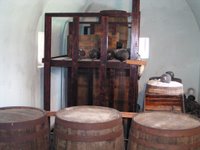 Gunpowder Magazine - constructed in 1814, located at the north-west of the fort and it was used to store explosives. It was designed to minimise the damaged caused by an explosion.
Gunpowder Magazine - constructed in 1814, located at the north-west of the fort and it was used to store explosives. It was designed to minimise the damaged caused by an explosion.  Seri Rambai facing the sea
Seri Rambai facing the sea
On a recent trip to Penang, I visited Fort Cornwallis at the Esplanade or Padang Kota Lama in Malay. The last time I visited the fort was in 1978.
In 1786, soon after he took possession of the island from the Sultan of Kedah, Francis Light erected a fort of nibong palms at the tip of the cape known as Tanjong Penaga. He named the fort after the Governor-General in Bengal, Charles Cornwallis.
The fort was later reconstructed in the same size, shape and layout. Convict labour which was first imported from India in 1789 was immediately put to work on the fort by Francis Light to rebuilt the fort in brick in 1793.
Fort Cornwallis was the first military and administrative base of the East India Company and the garrison of Fort Cornwallis consisted of a handful of Europeans, who resided within the fort and Sepoys, who dwelt in attap huts next to the fort.
The star-shaped fort mounted with cannons along the perimeter and the most famous of these cannons is the Seri Rambai which can be seen at the north-west bastion of the fort.
The Seri Rambai was presented to the Sultan of Johor by the Dutch. However, it was later given to Aceh and installed at Kuala Selangor. Finally, it was seized by the British and installed at Fort Cornwallis in 1871.


No comments:
Post a Comment